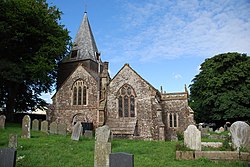Beaford
| Beaford | |
| Devon | |
|---|---|
 All Saints Church, Beaford | |
| Location | |
| Grid reference: | SS553149 |
| Location: | 50°54’58"N, 4°3’33"W |
| Data | |
| Post town: | Winkleigh |
| Postcode: | EX19 |
| Local Government | |
| Council: | Torridge |
Beaford is a village in northern Devon, on the east side of the River Torridge and about five miles south-east of Great Torrington, on the A3124 road towards Exeter. The 2001 census recorded a parish population of 393; in 1901 it had 428.[1]
The western boundary of the parish is formed by the River Torridge and it is surrounded, clockwise from the north, by the parishes of St Giles in the Wood, Roborough, Ashreigney, Dolton, Merton and Little Torrington.[2]
Parish church
The parish church in the village is dedicated to All Saints, though before the Reformation it was dedicated to St George.[3]
The church has a 15th-century doorway, arches and windows, as well as a Norman font. W. G. Hoskins (writing in 1954) reckoned the church to be otherwise dull, having been heavily restored in the Vicotrian Age.[4] The church tower was rebuilt with a small spire in 1910.[1]
History
Within the parish, the estates of Upcott, Warham and Woodleigh (otherwise known as Woolleigh or Wooleigh) were once important.[4]
Woolleigh was the seat of the Mallet family[5] until the death of Robert Mallet. His widow was Elizabeth Rolle[6] (a daughter of the wealthy George Rolle (died 1552) of Stevenstone near Great Torrington) who remarried to Sir John Acland (died 1620) of Columb John. During Elizabeth's lifetime the couple resided at Woolleigh.[7] Sir John's nephew, Sir Arthur Acland (died 1610) married Eleanor Mallet, the daughter and heir of Robert Mallet, and thus Wooleigh passed into the Acland family,[5] later of Killerton. The son and heir of Sir Hugh Acland, 5th Baronet (died 1713) was John Acland (died 1703) who lived at Wooleigh whilst his father lived at Killerton.[8]
The present farmhouse incorporates part of the mediæval manor house, a garderobe with its original door[9] and retains remains of a 15th-century family chapel.[4]
Greenwarren House in the village is the former home of Beaford Arts, the country's longest established rural arts centre. It is now a private family house.[10]
Sport and leisure
- Cricket: Beaford Cricket Club
Outside links
| ("Wikimedia Commons" has material about Beaford) |
References
- ↑ 1.0 1.1 Harris, Helen (2004). A Handbook of Devon Parishes. Tiverton: Halsgrove. p. 15. ISBN 1-84114-314-6.
- ↑ "Map of Devon Parishes". Devon County Council. http://www.devon.gov.uk/devon_districts_2002_.pdf. Retrieved 20 June 2013.
- ↑ Orme, Nicholas (1996). English Church Dedications. University of Exeter Press. p. 131. ISBN 0-85989-516-5.
- ↑ 4.0 4.1 4.2 Hoskins, W. G. (1972). A New Survey of England: Devon (New ed.). London: Collins. p. 330. ISBN 0-7153-5577-5.
- ↑ 5.0 5.1 "Wooleigh Barton". Mallett Family History. http://www.mallettfamilyhistory.org/tng/showalbum.php?albumID=29. Retrieved 29 November 2013.
- ↑ Vivian, pp. 3–8, pedigree of Acland, p. 4
- ↑ Prince, John (1643–1723): 'The Worthies of Devon' (1810 edition, pp. 1–6: biography of Sir John Acland)
- ↑ Vivian, p. 5 "John Acland of Wooleigh"; Acland, Anne. A Devon Family: The Story of the Aclands. London and Chichester: Phillimore, 1981, p. 13
- ↑ Nikolaus Pevsner: The Buildings of England: Devon, 1952; 1989 Penguin Books ISBN 978-0-300-09596-8page 161
- ↑ "Welcome". beafordarts. http://www.beaford-arts.org.uk/. Retrieved 29 November 2013.
- Vivian, Lt. Col. J. L., (Ed.) The Visitations of the County of Devon, Comprising the Heralds' Visitations of 1531, 1564 & 1620. Exeter, 1895
